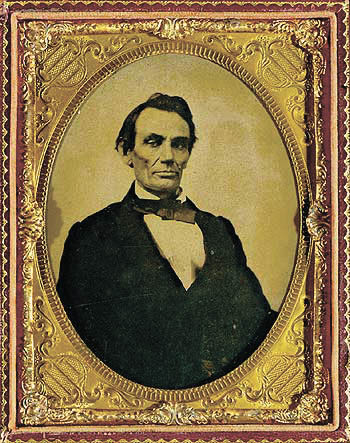BACKTRACKING
Lincoln in Monmouth
after "The Debate"
by Terry Hogan
Most of us are familiar
with the Lincoln and Douglas Debate, held at Knox College in Galesburg on
October 7, 1858. The debate was held at Old Main on the Knox Campus. Old Main
is the only remaining historic site of the seven debates that would help
determine who would be Illinois' senator. The debate was the fifth of seven
debates between Abe Lincoln and Stephen A. Douglas. Lincoln lost the senatorial
election to Douglas, but the debates thrust the relatively unknown Lincoln on
to the national political stage. With the proliferation of the telegraph and
the interest in the slave question, the debate received national and quick
coverage. The telegraph line was the CNN of the 1850's.
There is a very strong
argument to be made that without those debates, Lincoln would not have had the
subsequent opportunities to position himself for the Republican nomination for
President in 1860. The seven debates, each scheduled for a mind-numbing three
hours, gave Lincoln the opportunity to shine on "prime time". Even
though Lincoln was sent to the Senate, his debate skills, relying on a firm
legal style of oral argument, resulted in Lincoln being invited to speak at
various locations in the East. With each speech, the lanky, and homely man who
had been viewed as a sectionalist politician, became more and more recognized
as a national figure.
There is much written
about Douglas's arrival by special train at Galesburg and Lincoln's comparatively
low-key arrival, via Knoxville. There is also much written and described about
the content of the debate held at Knox, although the content and presentations
appeared to have been filtered by the reporter's political perspective. Just as
eye witnesses see events differently, so did those early reporters who attended
the debate. In the absence of tape recorders and electronic sound systems to
amplify voices, and in the political bias generally carried by newspapers, it
is not surprising that printed accounts of what was said, how it was received,
and who "won the debate" varied widely.
Nonetheless, the purpose
of this brief article is to address a much more narrow question. One that had
not occurred to me, and perhaps not to you. Where did Lincoln go and what did
he do in the next few days following the Galesburg debate?
According to an April
1896 article by Ida M. Tarbell, Abraham Lincoln that appeared in the McClure's
Magazine,
Lincoln traveled to Monmouth. On October 11, four days after the Galesburg
debate, Lincoln made a speech in Monmouth. Following the speech, the well known
Galesburg photographer, Harrison, took a photo of Lincoln in Monmouth. The
photo was an ambrotype. According to the Tarbell article, the photo, which was
reproduced in the McClure's Magazine, was owned by Mrs. W. J. Thomson of Monmouth.
The ambrotype shows a clean-shaven Lincoln with a face unlined by worry that
would come with the Civil War. It also shows a relatively good looking Lincoln
with carefully combed hair. His face was fuller than it would be in photos
taken in 1860, suggesting the loss of weight. The ambrotype was reported to
have been "hitherto unpublished" according to the McClure's caption
below the photograph.
I do not know where in Monmouth Lincoln spoke, nor do I know where specifically Harrison to ok the photo of Lincoln or how it was arranged. In 1860, it would have been a significant investment of time for Harrison to travel to Monmouth to take the photo. Thus, it seems likely that some sort of agreement had been reached with Lincoln before Harrison made the trip to Monmouth.
ok the photo of Lincoln or how it was arranged. In 1860, it would have been a significant investment of time for Harrison to travel to Monmouth to take the photo. Thus, it seems likely that some sort of agreement had been reached with Lincoln before Harrison made the trip to Monmouth.
I would guess that some
of the local historians in Monmouth would know about Lincoln's speech in
Monmouth, and perhaps it is also available in the Knox College archives of
Lincoln materials. But I do not have access to either.
If somebody has the
details about Lincoln's speech in Monmouth, I would enjoy hearing from them,
via The Zephyr.
As I read more and more about
Lincoln, I find a number of threads that tie Lincoln to Galesburg and Monmouth
that go well beyond the debate. It
would be interesting to put a little more flesh on the bare bone facts
presented in this brief article.